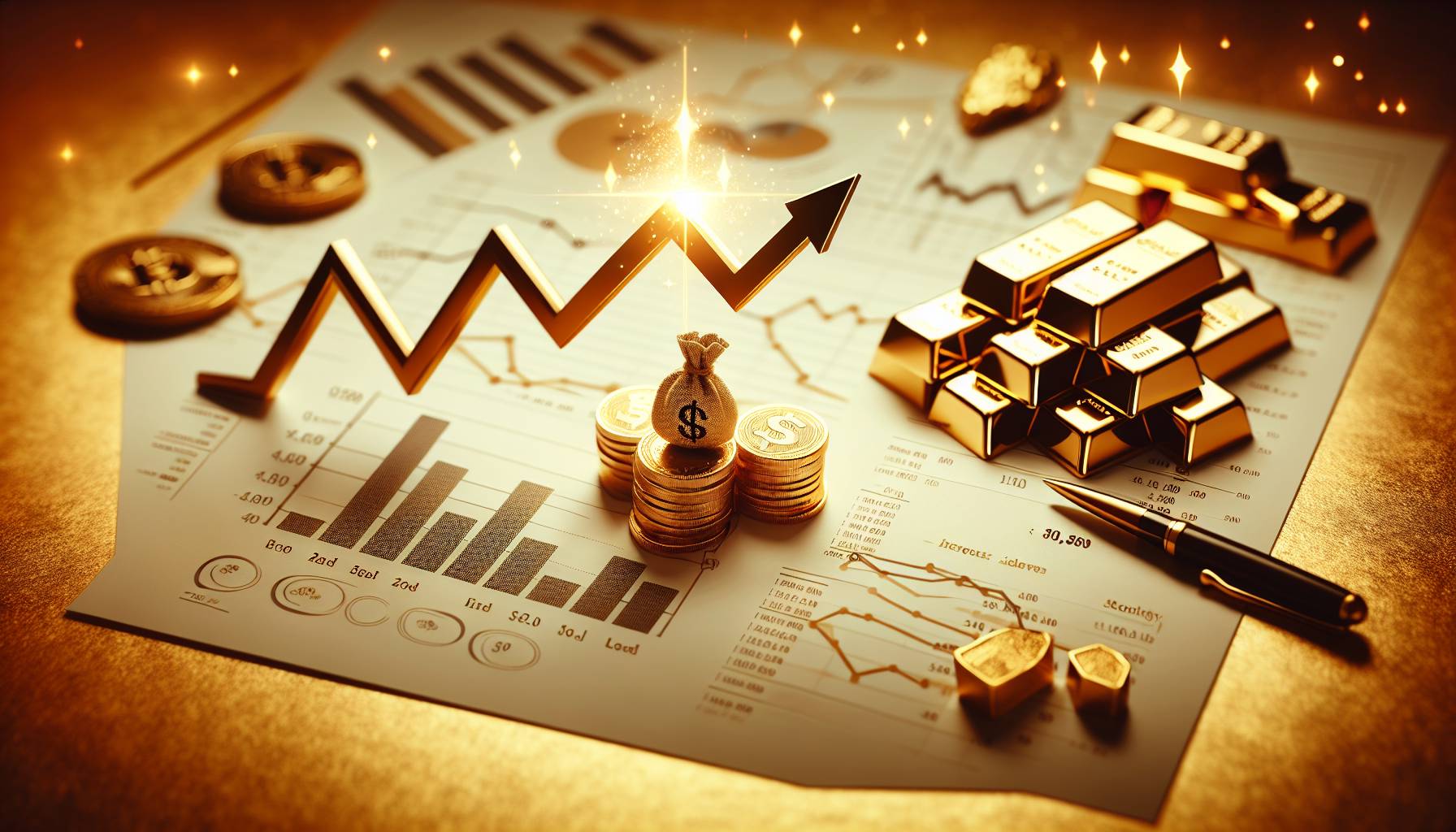analysis of recent gold price trends
Over the past 18 months, gold prices have shown a general upward trajectory. This increase can be attributed to a variety of economic and geopolitical factors that have influenced investor sentiment and market dynamics. During this period, gold has often been viewed as a safe-haven asset, particularly in times of uncertainty.
In early 2022, gold prices experienced a significant surge, reaching new highs as global tensions and inflationary pressures mounted. The onset of geopolitical conflicts and the ongoing impact of the COVID-19 pandemic contributed to heightened market volatility, prompting investors to seek refuge in gold.
As the year progressed, fluctuations in gold prices were observed, with periods of consolidation and minor corrections. However, the overall trend remained positive, supported by persistent concerns over inflation and currency devaluation. Central banks’ monetary policies, particularly in major economies, played a crucial role in shaping gold’s performance during this time.
In the first half of 2023, gold prices continued to rise, albeit at a more moderate pace. The market responded to mixed economic signals, including varying growth rates across different regions and ongoing supply chain disruptions. Despite these challenges, gold maintained its appeal as a hedge against economic instability.
Throughout this period, the Australian market also reflected these global trends, with local investors showing increased interest in gold as part of their diversified portfolios. The Australian dollar’s performance against other major currencies further influenced domestic gold prices, adding another layer of complexity to the market dynamics.
factors influencing gold prices
Several key factors have been influencing gold prices recently, shaping the market’s direction and investor behavior. One of the primary drivers is inflation. As inflation rates rise, the purchasing power of currencies tends to decrease, leading investors to seek assets like gold that traditionally hold value over time. This trend has been particularly evident in economies experiencing significant inflationary pressures, where gold serves as a hedge against currency devaluation.
Geopolitical tensions also play a crucial role in affecting gold prices. Events such as conflicts, trade disputes, and political instability can lead to increased market uncertainty, prompting investors to flock to safe-haven assets like gold. The ongoing geopolitical landscape, including tensions in Eastern Europe and trade negotiations between major economies, continues to impact investor sentiment and gold demand.
Monetary policy decisions by central banks are another significant factor. Interest rates, in particular, have a direct correlation with gold prices. When interest rates are low, the opportunity cost of holding non-yielding assets like gold decreases, making it more attractive to investors. Conversely, rising interest rates can lead to a stronger currency and reduced demand for gold. Central banks’ actions, especially those of the US Federal Reserve and the Reserve Bank of Australia, are closely monitored by market participants for indications of future gold price movements.
Additionally, currency fluctuations, particularly the strength or weakness of the US dollar, have a substantial impact on gold prices. Since gold is typically priced in US dollars, a weaker dollar makes gold cheaper for holders of other currencies, potentially boosting demand. Conversely, a stronger dollar can make gold more expensive and less attractive to international buyers.
Supply and demand dynamics within the gold market also influence prices. Factors such as mining output, recycling rates, and consumer demand for jewelry and technology can affect the overall supply and demand balance. In recent times, disruptions in mining operations and changes in consumer behavior have contributed to shifts in gold availability and pricing.
In the Australian context, local economic conditions, including the performance of the Australian dollar and domestic interest rates, further impact gold prices. Australian investors often consider these factors when making decisions about gold investments, adding a regional dimension to the global influences on gold pricing.
predictions for august
As we look towards August, several factors could influence the trajectory of gold prices. Analysts suggest that ongoing inflationary pressures may continue to support gold’s appeal as a hedge against currency devaluation. With central banks around the world, including the Reserve Bank of Australia, navigating complex economic landscapes, their monetary policy decisions will be pivotal. Any indications of interest rate adjustments could have a direct impact on gold’s attractiveness to investors.
Geopolitical developments remain a wildcard. Any escalation in global tensions or unexpected political events could drive investors towards safe-haven assets, potentially boosting gold demand. Conversely, resolutions or easing of tensions might lead to a shift in investor focus away from gold.
The performance of the US dollar will also be crucial. Should the dollar weaken, gold could become more affordable for international buyers, potentially increasing demand. However, a stronger dollar might dampen gold’s appeal, particularly in markets outside the US.
In Australia, the interplay between the Australian dollar and gold prices will be closely watched. A weaker Australian dollar could make gold more expensive domestically, influencing local investment decisions. Additionally, any changes in domestic economic indicators, such as employment rates or consumer confidence, could further impact investor sentiment towards gold.
While the general trend for gold has been upward, the market remains sensitive to a variety of factors. Investors will need to stay informed and agile, ready to respond to both global and local developments that could affect gold prices in August.
Factors influencing the rise in gold prices
Over the past 18 months, several key factors have contributed to the rise in gold prices. One of the primary drivers has been the global economic uncertainty, which has led investors to seek safe-haven assets like gold. Economic instability, particularly in major economies, has heightened the appeal of gold as a hedge against inflation and currency fluctuations.
Another significant factor is the monetary policy adopted by central banks worldwide. With interest rates remaining low, the opportunity cost of holding non-yielding assets like gold has decreased, making it a more attractive investment. Additionally, central banks themselves have been increasing their gold reserves, further supporting the upward trend in prices.
Geopolitical tensions have also played a role in boosting gold prices. Conflicts and trade disputes have created an environment of uncertainty, prompting investors to turn to gold as a reliable store of value. This trend is particularly evident in regions experiencing heightened political instability.
Moreover, the demand for gold in emerging markets, particularly in countries like China and India, has remained robust. These markets have a cultural affinity for gold, and rising incomes have enabled more consumers to invest in gold jewelry and bullion.
The supply side has also influenced gold prices. Mining output has not kept pace with demand, leading to tighter supply conditions. Environmental regulations and the depletion of easily accessible gold reserves have constrained production, contributing to the upward pressure on prices.
Predictions for gold prices in August
As we look ahead to August, several factors could influence the trajectory of gold prices. Analysts are closely monitoring the actions of central banks, particularly the Reserve Bank of Australia and the U.S. Federal Reserve. Any shifts in monetary policy, such as changes in interest rates or quantitative easing measures, could impact investor sentiment and gold demand.
Economic indicators will also play a crucial role. Inflation rates, employment figures, and GDP growth are key metrics that investors will watch to gauge economic health. If inflation continues to rise, gold may see increased demand as a hedge against eroding purchasing power.
Geopolitical developments remain a wildcard. Ongoing tensions in global hotspots or unexpected political events could drive investors towards gold as a safe haven. Additionally, trade relations, particularly between major economies, could influence market dynamics and investor behavior.
Market sentiment and speculative activity are other factors to consider. Investor confidence, driven by broader market trends and risk appetite, can lead to fluctuations in gold prices. A bullish sentiment in the gold market could sustain or even elevate prices further.
Lastly, seasonal demand patterns, especially from key markets like India, where festivals and weddings traditionally boost gold purchases, could provide additional support to prices in August. However, any significant changes in consumer behavior or economic conditions in these regions could alter this trend.

